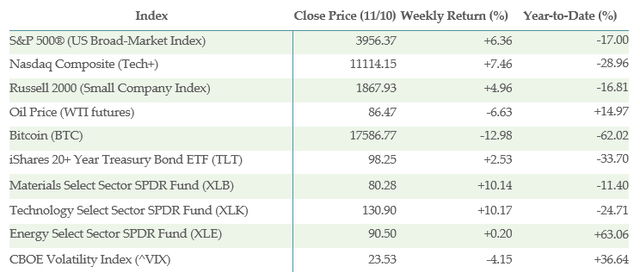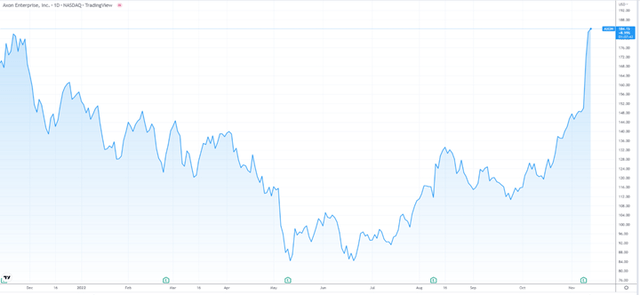Inflation is still very high, but showing signs of deceleration Khanchit Khirisutchalual
Brian Dress, CFA – Director of Research, Investment Advisor
Finally, some good news!
Throughout 2022, we have seen markets languish under the main theme of the year: inflation. Inflation has put pressure on business models in numerous sectors. Inflation has weighed on consumer and business confidence. And, most importantly, inflation has forced the Federal Reserve to pursue a hawkish monetary policy, causing ever-higher interest rates. Higher rates are the absolute enemy of positive stock market performance.
The current economic and market environment has made us all follow inflation with the most watchful of eyes. This week, at long last, we saw some signs that inflation is abating. On Thursday, the market digested the latest Consumer Price Index (CPI) report, which showed that price levels compared to a year ago were 7.7% higher on average. This is still an extremely high number, but came in below consensus expectations of 8.0% and last month’s reading of 8.2%. While this means that inflation remains high, what we are beginning to see is a deceleration in the overall price levels in the United States. This single report seems to have changed the sentiment of market participants, almost instantaneously.
We witnessed on Thursday one of the strongest one-day rallies in market history. We watched the S&P 500 gain more than 5% in value, while the tech-heavy NASDAQ Composite Index was higher by more than 7% on Thursday. Granted, this was probably accelerated by many investors who carried short positions into the event or who were underinvested. But when we see a market move like that, we sit up and take notice. Whether the momentum will continue is anybody’s guess, but the sense is palpable that things are beginning to shift.
Another major story gripped headlines this week and it was the collapse of one of the world’s largest cryptocurrency exchanges in FTX. CEO Sam Bankman-Fried had hoped to sell the company to another leader in crypto in Binance, but that deal fell through, this week. As a result, FTX is now moving into Chapter 11 Bankruptcy. Bitcoin itself fell by nearly 13% this week, in response. We think holders of cryptocurrencies may face a rocky road in the near term. We ourselves have avoided advising investors to allocate to this nascent asset class, but we understand the desire for investments with upside, which drove much of the craze. In today’s letter, we will talk about what we think are better ways to gain exposure to investments with upside.
With that all being said, let’s get into it!
Below is the performance data of key indices, ETFs for the five trading days between 11/3/22 and 11/10/22:
What is/is Not Working?
We saw one of the year’s best weeks in the markets, which you can glean from the index level dated cited above. With markets on the rise, predictably we had 10 of 11 sectors up on the week, with the one sector down being Energy (-0.03%). The leading sectors on the list were Materials (+10.08%), Information Technology (+9.98%), Real Estate (+8.57%), and Communications Services (+8.47%). These were some of the most beleaguered sectors throughout 2022. The fact that the year’s biggest losers led the market is evidence that short positioning played a role in the outperformance. But almost certainly there was some fresh buying on Thursday on the optimism driven by the more benign than expected inflation data. Time will tell.
From our database of more than 300 ETFs kept on our in-house software system, we had 19 which increased in value over the last week by 10% or more.
One news story that had a major impact on market psychology came out of China this week. We have been watching in dismay at the highly restrictive Covid policy that China has pursued since the beginning of the pandemic. This has caused significant hardship and economic slowdown for that country for nearly 3 years now. Given the economic importance of China, both from the supply chain perspective and from the consumption perspective, the strictness of the country’s Covid policy has been a headwind for virtually every company that operates there. This week we received some news that China is considering loosening the draconian rules around the pandemic.
A number of sectors will benefit most directly from this proposed policy change. Among them are some of the best performers over the last week, including the VanEck Semiconductor ETF (SMH; up 13.55%), iShares MSCI Global Metals & Mining Producers ETF (PICK; up 12.05%), and Invesco Solar ETF (TAN; up 10.38%).
We also saw profound strength in a number of foreign markets. This is another area where we have observed weakness throughout this year. All of these country ETFs gained more than 10% this week: iShares MSCI Germany ETF (EWG), iShares MSCI Italy ETF (EWI), iShares MSCI South Korea ETF (EWY), and iShares MSCI Taiwan ETF (EWT).
Crypto dominates the “What’s Not Working” list, with the five worst performing ETFs in our list coming from that sector. We will share additional thoughts below on crypto.
For the most part, ETFs that bet against the markets, both bonds and stocks, were the worst performing, and predictably so. The only ETF of note that dropped this week was the oil/gas pipeline focused Alerian MLP ETF (AMLP), which fell by 1.72% over the last week.
A Changing Inflation Picture; Change Comes to Silicon Valley
Inflation is the thief of (market) joy, a lesson we have learned in abundance over the last year. Inflation leads to higher interest rates and higher interest rates mean lower valuations on stocks, especially those in the growth arena. We are mindful that we have had moments earlier in 2022 where it appeared that inflation had peaked, only for things to backslide and inflation readings to come out hot again. Thus, the question that comes to mind is one whether we are in another temporary lull in prices or if we truly have reached peak inflation.
We know we may be going out on a limb here, but we think it is possible we truly have reached peak inflation and things may start to moderate in the coming months. There is data supporting this view all over the economy. We have started to see anecdotal evidence of falling prices in a number of areas: lumber, metals, food inputs, and now even used cars, which were one of the biggest drivers of inflation. The Federal Reserve has made its stated aim to attack the main causes of inflation. At the heart of this are two areas where prices have soared since the pandemic: the stock market and housing. The Fed is clear – they want asset prices lower and they have begun to find success. In some of the areas where housing prices soared the quickest, we are seeing evidence of a reversal, as mortgage rates tick above 7%. We have seen housing prices fall between 5-10% over the last 3 months in a number of the hottest western markets, including in California, Idaho, Colorado, and Washington.
We are starting to see signs that the Fed is willing to moderate its aggressive rate hiking stance. Just yesterday we heard from Philadelphia Federal Reserve Governor Patrick Harker, who stated “In the upcoming months, in light of the cumulative tightening we have achieved, I expect we will slow the pace of our rate hikes as we approach a sufficiently restrictive stance.” Harker indicated that perhaps the Fed will raise the Federal Funds Rate to 4.5%, pause, and see where things stand. We are getting to a point where we may be able to see light at the end of the tunnel for this current Fed tightening cycle.
For growth companies, accelerating revenue growth and an associated steady rise in share price are the rocket fuel for these businesses to continue to grow. It is a virtuous circle.
In 2022, we have watched that virtuous circle come to a screeching halt and large cap technology stocks have been some of the worst performing stocks on the board. With businesses of all types facing rising prices, they’ve looked for ways to cut back spending and this has hit software companies particularly hard. Beyond that, many of these serial growing companies have been borderline reckless with their spending and headcounts over the past years, as their stock prices seemed to do nothing but move higher.
In a sign of the times, we see the halcyon days in big tech coming to an end and efforts to rationalize headcounts through layoffs are happening at a number of major tech players. A great example of this is Meta Platforms (META) announcing a 13% cull of the workforce this week. From a shareholder perspective, we would like to see similar moves at other large tech firms, whose largess have cut dramatically into profits over the last year.
We continue to be cautious on large cap tech stocks, even with the strong rally over the last week. But there is no question that things have changed dramatically over the last week.
Crypto May Be Toast – What are Some Alternatives?
The rise of cryptocurrency has been meteoric over the past decade. We feel we see this phenomenon somewhat objectively, as we have spent this time on the sideline observing. It seems to us that there are two main groups of investors involved in crypto: (1) aggressive investors that saw cryptos prices moving ever higher in and wanted to in on a winning trend and (2) “mavericks” making a statement that they wanted to own an asset that has nothing to do with government, central banks, regulation, or the established monetary order. We are realistic that we have no chance to reach the second group. But those of you in the first group, we speak directly to you in this section.
What we saw this week with the collapse of FTX shows the inherent danger of investing in cryptocurrencies. Regulation is a mere afterthought for many of the operators in the space. CEO Sam Bankman-Fried (SBF) of FTX was colloquially referred to as the “JP Morgan of crypto,” indicating that he was one of the thought leaders in the space. We learned this week that SBF had misappropriated customer funds in an attempt to buoy a hedge fund he controlled, Alameda Research, which was underwater on a number of its crypto asset investments. From our point of view, if a proclaimed pillar of the digital asset space like Bankman-Fried is involved in such an egregious breach of personal trust, no crypto exchange is truly safe. Crypto investors: if you haven’t moved away from your investments yet, it is certainly time to consider it. Financial regulations are in place in our industry (wealth management) to protect the customer and we like it that way. No such arrangement seems to exist in crypto, so “buyer beware” is the only rule governing this space.
To the first group, which we consider the FOMO (Fear of Missing Out) crowd, we get it. As growth investors, we are very sympathetic to the concept of wanting investments to generate above-market returns. After all, take a look at the footer of our newsletter, which reads “Seeking Stocks that can Double in 2-3 Years”. In regulated markets, too, there are plenty of opportunities to get excited about.
Since growth stocks peaked in early 2021, some have fallen as much as 80% from their highs. Among this rubble, there are a number of interesting opportunities – companies whose businesses haven’t changed but whose stock prices have fallen precipitously. We have spoken of one such stock for many months now in the elective health care space: InMode (INMD). If you Google “InMode Left Brain”, you will find plenty of our work on the company.
We have been looking deep into the small and mid-cap space for investment ideas lately, especially given that we have noticed the persistent outperformance of the small-cap Russell 2000, relative to the broader market S&P 500. One company we like was in the mid-cap space ($2-10 billion market cap) before its earnings report on Wednesday, but now has inched back into the large cap area is Axon Enterprise (AXON). Formerly known as Taser, this company not only produces the well-known Tasers carried by many law enforcement personnel, but also now sells a suite of software and other evidence collection tools to police departments and militaries all over the world. In the US alone, more than 700,000 officers use Axon’s products.
We like the fact that Axon has transformed its business from a Taser sales operation to a business model that has recurring revenue. In the most recent quarter, Axon delivered 34% overall revenue growth, driven by a 40% annual increase in recurring revenue and Axon Cloud annual growth of 51%.
We have said many times in 2022 that we are skeptical of any company in the technology arena, just because the environment has been less than favorable for these sorts of companies. Investors are looking for companies with strong balance sheets, profits now (and not a promise for profits in the future), and strong competitive positioning. Axon has all of those qualities: the company has just $16 million in debt, versus nearly $400 million in cash, the company is profitable on the net income line, and Axon has very little competition in its space. Given all of those characteristics, we think there is a lot to like here.
To bring it back to the aggressive investors, many of which may have been neck-deep in the crypto space. We welcome you to consider a new way forward for your portfolio. That involves rolling up your sleeves to find exciting companies in the public markets (or engaging a financial professional to help). Every day we spend our time looking for promising companies like Axon. Axon actually is flirting again an all-time high (see one-year chart below) again after its strong earnings report, but the stock was down as much as 50% earlier this year. We think the more intrepid investors could benefit by sifting through similar companies, whose stocks are still deep in the red for 2022.
Takeaways from this Week
An old Chinese curse says something like “may you live in interesting times.” We are certainly in the midst of what I would consider “interesting times” in the markets. Things do seem to be improving, but we are only at the beginning phase of that improvement. Investors should be realistic and expect volatility to be a part of our investing life, so long as inflation and high interest rates dominate the discussion.
This week we saw the first signs that inflation is beginning to moderate and that the Federal Reserve is considering moderating its hawkish monetary stance. We will believe it when we see the Fed actually hold a board meeting and not hike rates by 0.75% next time, but we do think some cautious optimism is justified. With that being said, we will continue to concentrate at least some of our investment efforts in defensive sectors where we do see some growth, including energy, healthcare, insurance, and small and mid-cap stocks.
We have great sympathy for investors caught up in the morass that is cryptocurrency. We understand the impulse to look for above-average returns. We think it may be time to look away from digital assets and back toward the regulated public markets for such opportunities. Among these opportunities are a couple of our favorite small and mid-cap stocks InMode and Axon Enterprise.




Be the first to comment